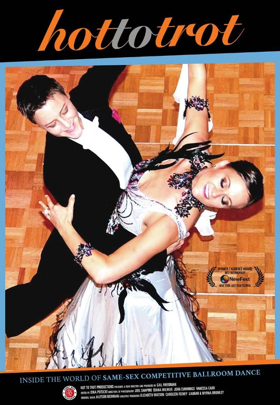Returning from an impromptu break in order to move to a new city, start a new job, and move into a new place without internet. We're definitely hoping to be back on the weekly schedule looking at documentaries as we head into awards season. I'm exhausted already! - Glenn Dunks
 The strangest thoughts can go through your head as a movie plays in front of you. As I was watching Gail Freedman’s affectionately-made Hot to Trot about competitive same-sex ballroom dancing, I began to think about the evolution of documentary and the representation of gay stories in it. There isn’t anything in the film that really justifies such lofty thoughts, but I couldn’t help wondering what audiences 20 years ago would have made of it and how simple stories are done a disservice by expectations placed on non-fiction moviemaking...
The strangest thoughts can go through your head as a movie plays in front of you. As I was watching Gail Freedman’s affectionately-made Hot to Trot about competitive same-sex ballroom dancing, I began to think about the evolution of documentary and the representation of gay stories in it. There isn’t anything in the film that really justifies such lofty thoughts, but I couldn’t help wondering what audiences 20 years ago would have made of it and how simple stories are done a disservice by expectations placed on non-fiction moviemaking...
I mean, how often do you hear disparaging comments about documentaries that they felt like television, were too basic or rudimentary, and weren’t stylish enough? I see it a lot for movies like Hot to Trot which, once upon a time, would be the sort of documentary that a company like Miramax or HBO would release and cause a buzz. Something like Paris is Burning, Madonna: Truth or Dare, or Unzipped, which cut through the mainstream and brought queer stories with them.
Freedman’s film isn’t as good as those classics but as a work of documentary – basic, rudimentary documentary – it got me thinking about how we often place too high of a burden on documentaries to be more than just a good story told through the lens of non-fiction. Is Hot to Trot too mild-mannered? Now that queer stories so many probably think you need to be doing something truly special to matter. Is it enough for a movie to just be nice and pleasant and to sign its story off in swift 88 minutes?
If it sounds like I am circling the actual movie at hand then that’s probably because there isn’t all that much to say about it. It’s old-fashioned in form and story, although there is drama to be found in the shifting sands of the dance partnerships at its core. There’s little directorial verve to the picture, although it is elevated by the sequins and the frou frou of its glamorous world of ballroom and the ways they interract with the city around them. Its highs and lows are treated with an almost too casual observance, although I liked that it didn’t treat its world of same-sex ballroom dance – or the Gay Games that they attend at the movie’s climax aspiring to win gold at – as trivial, quirky or like second-best.

I enjoyed the dancing, I liked the way its two stories weaved throughout one another, and I thought its subjects were for the most part fun individuals worth spending time with even if the filmmaking doesn’t want to let us in too much. There’s warmth here, but it's probably too tepid for a film which has the word “hot” in its title and includes a moment where dancing is described as a vertical interpretation of horizontal desires. Nevertheless, I imagine many will glide along to its groove, wishing the best for its men and women, caring little about anything other than a glimpse into an unfamiliar world and a charmingly gay experience.
This doesn't feel like a film of 2018 so I felt something akin to nostalgia while watching Hot to Trot and that that felt strangely appropriate considering its subject matter. It’s worth blocking out the world for just a little bit for it.
Release: Playing the Quad in NYC followed by single-screen engagements in LA, Lafayette, San Francisco, Pleasantville and Rosendale. No doubt on demand services in the near future.